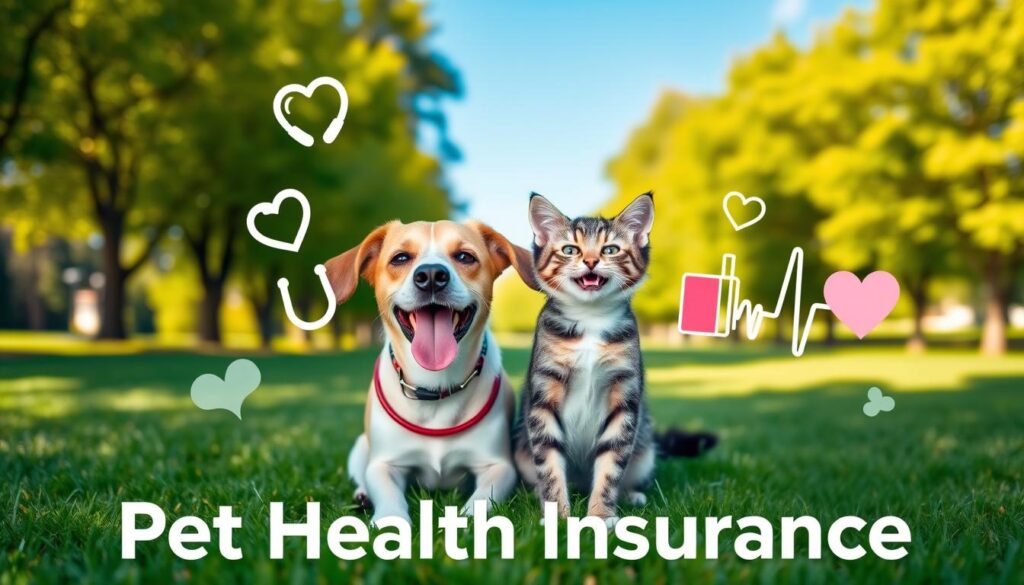In today’s world, our pets have become more than just companions – they are beloved members of our families. As pet owners, we strive to provide the best possible care for our furry friends, ensuring their health and well-being. But what happens when unexpected medical emergencies or illnesses arise? This is where pet insurance coverage steps in, offering a financial safety net and giving pet owners the peace of mind they deserve.
Have you ever wondered if your pet’s healthcare needs are adequately covered? With pet insurance, you can rest assured that your four-legged friend will receive the necessary treatment, no matter the cost. But is pet insurance truly worth the investment? What are the key factors to consider when selecting the right pet insurance plan for your beloved pet? Discover the answers in this comprehensive guide as we explore the world of pet insurance coverage.
Key Takeaways
- Understand the basics of pet insurance and its importance in protecting your pet’s health and your finances.
- Explore the different types of pet insurance plans available, including accident-only, illness, wellness, and comprehensive coverage.
- Learn about the key features of pet insurance, such as deductibles, premiums, coverage limits, and reimbursement options.
- Discover common exclusions in pet insurance policies and how to navigate them.
- Gain insights on how to choose the right pet insurance plan for your furry friend.
Understanding Pet Insurance Coverage
In the ever-evolving landscape of pet healthcare, pet insurance has emerged as a vital tool for responsible pet owners. But what exactly is pet insurance, and why is it so crucial? Let’s dive into the world of pet insurance and explore its significance in safeguarding the well-being of our furry companions.
What is Pet Insurance?
Pet insurance is a type of insurance coverage designed to help pet owners manage the costs associated with unexpected veterinary expenses. Much like health insurance for humans, pet insurance can provide financial protection against the high costs of medical treatments, surgical procedures, and even preventative care for your pets. By sharing the financial burden, pet insurance empowers pet owners to make informed decisions about their pet’s healthcare without worrying about the price tag.
Why Do You Need It?
Veterinary care costs have been steadily rising in the United States, making it increasingly challenging for pet owners to afford the necessary treatments for their beloved companions. According to the American Pet Products Association, the average pet owner in the U.S. spent over $1,000 on veterinary care in 2021. With unexpected illnesses, injuries, or chronic conditions, these costs can quickly escalate, putting a strain on a family’s finances. Pet insurance offers a safety net, allowing pet owners to focus on their pet’s well-being without the added stress of unaffordable medical bills.
“Pet insurance can be a game-changer, providing financial protection and peace of mind when our pets need it most.”
By investing in pet insurance, pet owners can rest assured that their furry friends will have access to quality healthcare, without the fear of breaking the bank. This coverage can prove invaluable in managing the costs of essential treatments, specialized care, and even life-saving procedures.
As the veterinary industry continues to advance, the importance of pet insurance becomes increasingly evident. By understanding the benefits and coverage options available, pet owners can make informed decisions to ensure their pets receive the care they deserve, without compromising their financial well-being.
Types of Pet Insurance Plans
When it comes to protecting your furry friend, there are various types of pet insurance policies to consider. Understanding the differences between accident-only, illness, wellness, and comprehensive coverage can help you choose the best plan for your pet’s unique needs and your budget.
Accident-Only Coverage
As the name suggests, accident-only pet insurance policies provide coverage for injuries and accidents, such as broken bones, bite wounds, or ingestion of foreign objects. This type of plan is typically the most affordable, making it a suitable option for pet owners on a budget.
Illness Coverage
Illness coverage pet insurance plans offer protection for your pet’s health, covering the costs associated with veterinary treatment for conditions like cancer, infections, and chronic diseases. This type of plan is essential for pet owners who want to ensure their furry friends receive the necessary medical attention.
Wellness Plans
- Wellness plans, also known as routine care coverage, provide reimbursement for preventive services such as vaccinations, routine check-ups, and routine dental cleanings.
- These plans can help pet owners manage the ongoing costs of maintaining their pet’s health and well-being.
Comprehensive Coverage
For the ultimate peace of mind, comprehensive pet insurance policies combine accident, illness, and wellness coverage into a single plan. This type of plan offers the broadest protection, covering a wide range of medical expenses, from unexpected emergencies to routine preventive care.
When selecting a pet insurance policy, it’s crucial to carefully evaluate your pet’s healthcare needs and your budget to determine the most suitable coverage option. By understanding the different types of pet insurance plans, you can make an informed decision and ensure your beloved companion receives the care they deserve.
| Plan Type | Coverage | Typical Cost |
|---|---|---|
| Accident-Only | Injuries and Accidents | $10-$20 per month |
| Illness | Illnesses and Diseases | $20-$40 per month |
| Wellness | Routine Preventive Care | $10-$25 per month |
| Comprehensive | Accidents, Illnesses, and Wellness | $30-$70 per month |
Remember, the cost of pet insurance policies can vary based on factors such as your pet’s age, breed, location, and the coverage options you choose. It’s essential to research and compare different providers to find the best plan that fits your needs and budget.
Key Features of Pet Insurance
When it comes to pet insurance, understanding the key features of your policy is crucial. From deductibles and premiums to coverage limits and reimbursement options, these elements can have a significant impact on the overall cost and effectiveness of your pet’s protection. Let’s dive into the details to help you make an informed decision.
Deductibles and Premiums
The deductible is the amount you pay out-of-pocket before your pet insurance coverage kicks in. Typically, the higher the deductible, the lower your monthly premium. On the other hand, a lower deductible may result in a higher premium. Striking the right balance between these two factors can help you find a plan that fits your budget and provides the coverage your furry friend needs.
Coverage Limits
Pet insurance policies often come with coverage limits, which cap the amount the insurer will pay out per incident or per year. These limits can range from a few thousand dollars to unlimited coverage. Understanding your pet’s potential healthcare needs can help you choose a plan with sufficient coverage limits to ensure your pet is well-protected.
Reimbursement Options
Most pet insurance providers offer reimbursement-based plans, where you pay the veterinary bills upfront and then submit a claim for partial or full reimbursement. The reimbursement percentage can vary, with some plans covering 70-90% of eligible expenses. Selecting a plan with a higher reimbursement rate can help minimize your out-of-pocket costs.
| Feature | Explanation |
|---|---|
| Deductibles | The amount you pay out-of-pocket before your pet insurance coverage kicks in. |
| Premiums | The monthly or annual fee you pay for your pet insurance policy. |
| Coverage Limits | The maximum amount your insurer will pay out per incident or per year. |
| Reimbursement Options | The percentage of eligible expenses your insurer will reimburse you for. |
Understanding these key features of pet insurance can help you select a policy that provides the right balance of coverage and cost for your furry friend’s pet accident coverage and pet injury insurance needs.
Common Exclusions in Pet Insurance
When considering pet insurance, it’s important to understand the common exclusions that may limit your coverage. While pet insurance can provide valuable financial protection, there are certain conditions and procedures that are typically not covered. Let’s explore some of the most common exclusions to help you set realistic expectations for your pet’s healthcare coverage.
Pre-existing Conditions
One of the primary exclusions in pet insurance policies is pre-existing conditions. These are medical issues that your pet had before the policy was initiated. Insurance providers often exclude pre-existing conditions from coverage, as they are considered a known risk. It’s crucial to disclose any pre-existing conditions your pet may have during the enrollment process to ensure you understand the limitations of your coverage.
Cosmetic Procedures
Elective or cosmetic procedures, such as ear cropping, tail docking, or declawing, are generally not covered by pet insurance. These procedures are often considered non-essential and are typically excluded from standard pet healthcare coverage. If you’re considering any cosmetic procedures for your pet, it’s essential to check with your insurance provider to understand the limitations of your plan.
Routine Care
While some pet insurance plans may offer optional wellness coverage, routine care, such as annual checkups, vaccinations, and routine dental cleanings, are often not included in the standard policy. These preventative services are usually considered the responsibility of the pet owner, and it’s important to factor in the cost of routine care when budgeting for your pet’s healthcare needs.
By understanding the common exclusions in pet insurance, you can make informed decisions about the coverage that best suits your pet’s needs and your financial situation. This knowledge will help you navigate the pet insurance landscape and ensure that your furry friend receives the care they deserve, while minimizing unexpected out-of-pocket expenses.
| Exclusion | Description |
|---|---|
| Pre-existing Conditions | Medical issues your pet had before the policy was initiated |
| Cosmetic Procedures | Elective or non-essential procedures, such as ear cropping, tail docking, or declawing |
| Routine Care | Preventative services like annual checkups, vaccinations, and routine dental cleanings |
“Understanding the exclusions in pet insurance is crucial to making an informed decision about the right coverage for your furry friend.”
How to Choose the Right Plan
Selecting the right pet insurance plan can be a daunting task, but with the right approach, you can find the coverage that best suits your furry friend’s needs. Whether you’re looking for pet insurance coverage or animal insurance plans, the key is to carefully assess your pet’s specific requirements and compare different providers to find the most suitable option.
Assessing Your Pet’s Needs
Begin by evaluating your pet’s current and potential healthcare needs. Consider factors such as their age, breed, and any pre-existing conditions. This will help you determine the level of coverage you require, from accident-only to comprehensive plans that include illness and wellness care.
Comparing Different Providers
- Research various pet insurance providers and their policy offerings to find the best fit.
- Compare factors like deductibles, coverage limits, and reimbursement rates to ensure you’re getting the most value for your money.
- Look into the provider’s reputation, customer service, and claims processing efficiency to ensure a seamless experience.
Reading Customer Reviews
Utilize customer reviews to gain valuable insights into the experiences of other pet owners with different insurance providers. This can help you identify potential strengths and weaknesses of each plan, as well as any recurring issues or concerns that may inform your decision-making process.
“Choosing the right pet insurance plan is crucial for protecting your furry friend and your wallet. Taking the time to research and compare options can make all the difference in ensuring your pet receives the care they need.”
By following these steps, you can make an informed decision and select the pet insurance plan that best meets your pet’s unique needs, providing you with the peace of mind and financial protection you deserve.
The Benefits of Pet Insurance Coverage
Investing in pet health insurance can provide numerous advantages for pet owners. From financial protection to access to quality healthcare, pet insurance offers invaluable peace of mind when it comes to caring for your furry friend.
Financial Protection
Unexpected veterinary expenses can quickly add up, leaving pet owners in a difficult financial situation. Pet insurance helps mitigate these costs by reimbursing a portion of the medical bills, allowing pet owners to focus on their pet’s wellbeing rather than worrying about the financial burden.
Access to Quality Healthcare
With pet insurance coverage, pet owners can confidently take their pets to the best veterinary clinics and specialists, ensuring they receive the highest level of care. This access to quality healthcare can be especially beneficial for pets with chronic conditions or in need of specialized treatments.
Peace of Mind
Owning a pet can be a rewarding experience, but it also comes with its fair share of concerns. Pet health insurance provides pet owners with the peace of mind knowing that their beloved companion is protected in the event of unexpected illnesses or injuries. This allows pet owners to enjoy their time with their pets without constant worry about the financial implications of veterinary bills.
In conclusion, pet medical insurance offers a comprehensive solution for pet owners, providing financial protection, access to quality healthcare, and the invaluable peace of mind that comes with knowing your pet’s wellbeing is safeguarded.

Real-Life Examples of Pet Insurance Value
Pet insurance can be a lifesaver when unexpected medical emergencies or chronic conditions arise. Let’s explore a few real-life examples that showcase the true value of having pet insurance policies in place.
Case Study: Major Surgery Costs
Consider the case of Bella, a 7-year-old Labrador Retriever who recently underwent hip replacement surgery. The total cost of the procedure, including pre-operative tests and post-operative care, amounted to $12,000. Thankfully, Bella’s pet insurance policy covered 80% of the expenses, leaving her owners responsible for only $2,400 out-of-pocket. Without the insurance, they would have faced a financial burden of $12,000, which could have been devastating.
Routine Visits and Preventative Care
- Regular check-ups and preventative care, such as vaccinations, flea/tick prevention, and dental cleanings, can add up quickly. Pet insurance policies that include wellness coverage can help offset these routine expenses.
- For example, Penny, a 3-year-old Domestic Shorthair cat, has an annual wellness plan that covers the cost of her yearly checkup, vaccinations, and flea/tick medication. This coverage has saved her owners hundreds of dollars, ensuring Penny receives the necessary preventative care to maintain her health.
These real-life examples demonstrate the value of pet insurance policies in providing financial protection and access to quality healthcare for beloved furry companions. By covering major medical costs and routine expenses, pet insurance can give pet owners peace of mind and help ensure their pets receive the care they need.
How to File a Claim
Filing a claim for pet accident coverage or pet injury insurance can seem daunting, but with the right steps, the process can be smooth and efficient. Whether you’re seeking reimbursement for an unexpected veterinary visit or a major surgical procedure, understanding the claim filing process is key to getting your pet the care they need.
Step-by-Step Guide to Filing a Claim
- Review your pet insurance policy to understand the coverage details and any specific claim filing requirements.
- Gather all the necessary documentation, including your veterinary records, itemized invoices, and proof of payment.
- Contact your pet insurance provider and request a claim form, or download it from their website.
- Complete the claim form accurately and provide all the required information, such as your pet’s details, the nature of the claim, and the total expenses.
- Submit the claim form, along with the supporting documentation, either online, via email, or by mail, depending on your provider’s preferred method.
Tips for Quick Claim Approval
- Respond promptly to any requests for additional information from your insurance provider.
- Ensure all documentation is clear, legible, and includes the necessary details.
- Be aware of your policy’s deductible and reimbursement levels to manage your expectations.
- Follow up on the status of your claim if you don’t receive a response within the expected timeframe.
By understanding the step-by-step process and following these tips, you can streamline the pet insurance claim filing experience and get your pet the coverage they need for their pet accident coverage or pet injury insurance.
Frequently Asked Questions
When it comes to pet insurance coverage, pet owners often have several questions about the scope and limitations of these policies. Here are some of the most frequently asked questions, along with clear and concise answers to help you better understand your pet insurance options.
What Pets Can Be Insured?
Pet insurance is typically available for a variety of domestic animals, including dogs, cats, rabbits, and even exotic pets like birds and reptiles. The specific types of pets that can be insured may vary by provider, so it’s essential to check with your chosen insurance company to see if your furry (or feathery) friend is eligible.
Age Restrictions for Coverage
- Most pet insurance providers offer coverage for pets as young as a few weeks old, making it possible to insure your new family member from the very beginning.
- However, age restrictions may apply for older pets, with some insurers setting upper limits on the maximum age for enrollment, typically around 10-14 years old for dogs and 10-15 years old for cats.
- It’s important to note that age may also affect the types of coverage available and the premiums charged, as older pets are more likely to develop pre-existing conditions or require more extensive medical care.
Remember, the key to finding the right pet insurance coverage is to research your options thoroughly and choose a policy that meets the specific needs of your beloved companion. By understanding the coverage limitations and age requirements, you can ensure that your pet is protected throughout their lifetime.

The Cost of Pet Insurance
When it comes to protecting your furry friend’s health, pet insurance can be a valuable investment. However, the cost of pet insurance is a crucial factor to consider. From monthly premiums to unexpected expenses, understanding the financial implications of pet insurance can help you make an informed decision that aligns with your pet’s needs and your budget.
Monthly Premiums vs. Unexpected Expenses
The monthly cost of pet insurance premiums can vary widely, depending on factors such as your pet’s age, breed, location, and the coverage level you choose. While these premiums may seem like an ongoing expense, they can provide valuable protection against the potentially high costs of unexpected veterinary care. Unexpected expenses, such as emergency surgeries or chronic illnesses, can quickly add up and become a financial burden without the proper insurance coverage.
Budgeting for Pet Care
When planning your pet’s healthcare budget, it’s essential to consider not only the cost of pet insurance premiums but also the additional expenses that come with owning a pet. This includes routine check-ups, preventive care, and any other regular veterinary needs. By creating a comprehensive budget that accounts for both insurance costs and other pet-related expenses, you can ensure that your furry friend receives the care they need without straining your finances.
| Monthly Pet Insurance Premium | Average Cost of Unexpected Veterinary Expenses |
|---|---|
| $35 – $100 | $500 – $5,000+ |
The table above provides a general comparison between monthly pet insurance premiums and the potential costs of unexpected veterinary expenses. While the monthly premiums may seem high, they can offer significant financial protection against the often-substantial costs of major medical treatments or surgeries for your pet.
Investing in pet insurance can be a wise decision to safeguard your pet’s health and your financial wellbeing. By understanding the cost of pet insurance and budgeting for comprehensive pet care, you can ensure that your furry friend receives the best possible medical attention without straining your budget.
Myths About Pet Insurance
When it comes to pet insurance, there are several common misconceptions that often discourage pet owners from exploring this valuable coverage option. However, understanding the realities of pet insurance can help dispel these myths and demonstrate the true benefits it can provide. Let’s dive into the facts and debunk the most prevalent myths surrounding pet insurance.
Common Misconceptions
- Pet insurance is too expensive. While the cost of pet insurance can vary, it’s important to consider the potential costs of unexpected veterinary expenses, which can often exceed the monthly premiums. Pet insurance can help provide financial protection and peace of mind.
- Pet insurance doesn’t cover pre-existing conditions. This is not entirely accurate. Many pet insurance policies do exclude pre-existing conditions, but some may cover certain conditions if they are deemed treatable and the pet has been symptom-free for a specific time period.
- Pet insurance is only for emergencies. While pet insurance can certainly help cover the costs of unexpected accidents or illnesses, many policies also provide coverage for routine and preventive care, such as vaccinations, wellness exams, and routine dental cleanings.
Realities of Pet Insurance Coverage
The truth is that pet insurance can be a valuable investment for pet owners, providing financial protection and access to quality healthcare for their furry companions. By understanding the myths and realities of pet insurance, pet owners can make informed decisions about the best coverage options for their pets.
| Myth | Reality |
|---|---|
| Pet insurance is too expensive | Pet insurance can help offset the high costs of unexpected veterinary expenses, which can often exceed the monthly premiums. |
| Pet insurance doesn’t cover pre-existing conditions | Some pet insurance policies may cover certain pre-existing conditions if they are deemed treatable and the pet has been symptom-free for a specific time period. |
| Pet insurance is only for emergencies | Many pet insurance policies provide coverage for routine and preventive care, such as vaccinations, wellness exams, and routine dental cleanings. |
“Investing in pet insurance can provide invaluable protection and peace of mind for pet owners, ensuring their furry friends receive the quality healthcare they deserve.”
Future of Pet Insurance Coverage
As the pet insurance industry continues to evolve, experts predict exciting trends and innovative policy offerings on the horizon. With an increasing focus on pet illness coverage and comprehensive animal insurance plans, the future of pet insurance promises greater protection and peace of mind for pet owners.
Trends in the Industry
The pet insurance market is poised for substantial growth, driven by rising veterinary costs and heightened awareness of the importance of coverage. Insurers are responding by expanding their policy options, including specialized plans for unique pet needs, such as chronic conditions and advanced treatments. Additionally, the integration of technology is streamlining the claims process, making it easier for pet owners to access the care their furry friends deserve.
Innovations in Policy Offerings
In the coming years, pet insurance providers are expected to introduce innovative policy offerings that cater to the diverse needs of pet owners. This includes the development of personalized plans that account for a pet’s age, breed, and pre-existing conditions, ensuring comprehensive coverage tailored to individual needs. Furthermore, the industry is exploring the incorporation of wellness benefits, covering routine checkups and preventative care, to promote the overall health and well-being of pets.





